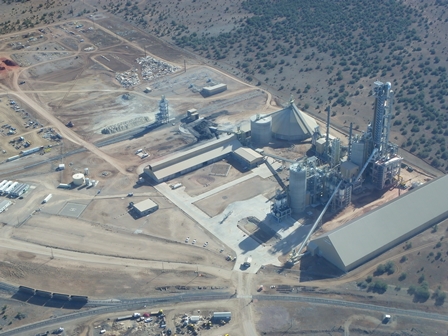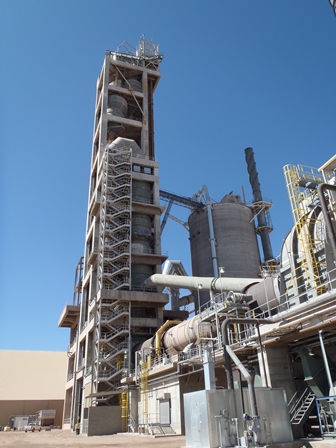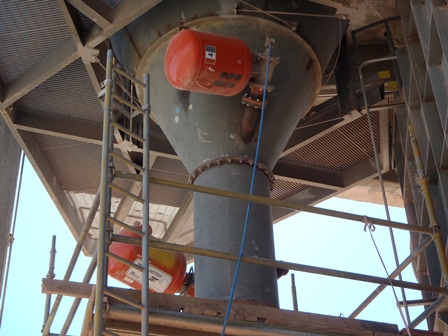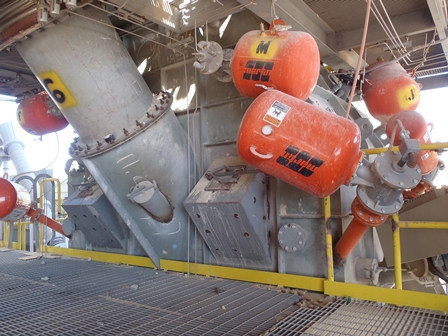Published: August 2nd 2016

Drake Cement is the newest cement company in the Southwest, with operations beginning at the Arizona plant in 2011. The firm specializes in high quality Portland cement products for the North American market, while improving the local availability of a critical building material. Located at the site of an old rail town about ten miles north of Paulden, the facility includes a state-of-the-art, six-stage precalciner / preheater with a rated capacity of 660,000 tons of clinker per year. Some of the operating and pollution controls incorporated into the process are so advanced that they are found in only a few other facilities throughout the world.
Efficient material flow is a key component of Drake’s dry-process manufacturing, and accumulation in storage bins, process vessels or feed pipes could choke even this well-designed system. Blockages can create expensive obstacles to equipment performance and process efficiency, raising maintenance expenses and diverting manpower from core business activities, in some cases introducing safety risks for personnel.
Engineers designing the Drake process initially specified 15 air cannons from Martin Engineering in critical locations to control accumulation and enhance material flow. Introduced by Martin Engineering in 1974, air cannon technology has developed a proven track record around the world for relieving bulk material bottlenecks. The Martin® Extra High Velocity Air Cannons at Drake Cement fire a powerful discharge of compressed air to remove material adhered to the vessel walls.

“The original cannons were located in the entry to the kiln, cooler inlet and the preheater tower,” recalled Engineering & Projects Manager Antonio Quiroz. “We were already familiar with Martin Engineering’s designs from our two other operations in Peru, and we wanted to stay with the technology that was working well for us in those plants.”
Like most new cement plants, Quiroz knew that the Drake facility would likely require some fine-tuning of material flow to optimize the process. “Any time you start up a new process, there are always small adjustments to be made to maximize material flow,” observed Quiroz. “It usually doesn’t take long to identify potential bottlenecks.”
After initial trials, Drake engineers shut down the system to examine the process and identified some additional areas where material flow could be enhanced. “Rather than running production and having to shut down for maintenance to clear accumulations, we wanted to prevent them from occurring,” Quiroz said. Martin Engineering technicians visited the site and pinpointed the optimum locations for additional cannons in the plant’s additive silos and in the bottom part of the preheater, as well as the calciner and cyclones.
The facility now has a total of 53 air cannons, with the timing and firing sequence determined primarily by programmable logic control. “The PLC tracks variables such as pressures and temperatures, and those values dictate which cannons fire and when,” Quiroz continued. “The system is also set up to allow operators to fire individual cannons or groups of them, based on experience.”
The air cannon design requires no high-temperature discharge pipes or special mounting plates, and discharge nozzles are embedded directly in refractory linings. All of the units in the network are equipped with valves designed to deliver reliable performance and long service life in high-temperature applications.

The original cannons were fitted with Martin Engineering’s Extra High Velocity Air Cannon valves, while those added later contained the newer Tornado Ultimate Air Cannon valve design. The Extra High Velocity equipped air cannons supply a quiet but powerful discharge of compressed air to dislodge material buildups and enhance the flow of bulk solids. They deliver excellent performance in high-temperature applications, even with the most challenging materials. Designed for severe-duty applications where exposure to elevated service temperatures and harsh gases can affect performance, the XHV has proven successful in applications such as outside cement kiln pre-heaters where interior temperatures reach up to 2,500°F (1,371°C).
The negative pressure-firing valve is constructed with a rugged, high-temperature polymer seal for dependability and low maintenance. The advanced design delivers high output force and excellent sealing, as well as rapid discharge and filling. All Extra High Velocity Air Cannon valves are guaranteed for 200,000 firings, and a removable piston seat simplifies service.
Available in 2, 4 and 6-inch models and ten different tank sizes, the Extra High Velocity Air Cannon Valve Assembly features an aluminum piston with a very short stroke (just 5/8" or 16 mm), minimizing wear on the piston and cylinder. A return spring snaps the piston quickly back into firing position and prevents dust entry.
The patent-pending Tornado Ultimate Valve was designed to enhance material flow with even greater force and faster cycling. The cannons fire when the exhaust valve opens in response to a positive surge of air sent by a tripped solenoid. This positive-acting valve amplifies the discharge, providing up to 20% more force than a standard air cannon of the same size. In addition, the improved air path of the Tornado Ultimate fills the reservoir 3-4 times faster than typical designs.

According to Quiroz, the efforts have been very successful. “We’re now running at our rated capacity of about 100 short tons per hour,” he said. “We haven’t had any accumulation issues in almost a year, so we’ve avoided shutdowns for manual cleanout and the maintenance costs that go with it.”
Currently, Drake Cement concentrates exclusively on the production of Type II / V(LA) Portland cement, conforming to the physical and chemical requirements of ASTM C-150 for Types I, II and V low-alkali cements, as well as ASTM C 1157 for Types GU, MS and HS cements. Drake Cement Type II/V(LA) can be used in any general construction application, including those with exposure to moderate or high levels of sulfates in soils and/or water. In addition, the low levels of alkalis in Drake Cement Type II/V(LA) Portland Cement reduce the potential for damage due to alkali-silica reactivity (ASR).
The Drake facility takes full advantage of local resources, with limestone and silica mined from its nearby quarry and stored in large silos. After blending with iron and alumina, the mixture is ground and fed through the preheating tower and into the kiln. The resulting clinker is stored until final grinding into cement, with a small amount of gypsum added. The finished product is stored until it can be loaded into trucks or rail cars.
The site’s high capacity rail switching facility is located on the BNSF mainline railway, expected to encourage further development in the area by offering other companies access to raw materials, energy and distribution capabilities near the attractive Interstate 40 and U.S. 93 transportation corridors.